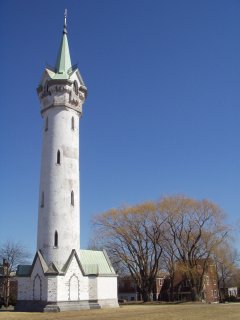User:KoalVlachos/sandbox4
Roxbury High Fort | |
 Cochituate Standpipe (built 1869) | |
| Location | Boston, Massachusetts |
|---|---|
| Coordinates | 42°19′31″N 71°5′40″W / 42.32528°N 71.09444°W |
| Area | Highland Park, Boston |
| Built | 1775 (fort); 1869 (tower); 1895 (park) |
| Architect | Standish & Woodbury; Olmsted, Frederick Law |
| Architectural style | Gothic-Revival |
| Part of | Roxbury Highlands Historic District (ID89000147) |
| NRHP reference No. | 73000856[1] |
| Significant dates | |
| Added to NRHP | April 23, 1973 |
| Designated CP | February 22, 1989 |
Roxbury High Fort is a historic fort site within Highland Park in the Roxbury neighborhood of Boston, Massachusetts. The park grounds are shared with the Cochituate Standpipe, also known as the Fort Hill Tower. The fort site was added to the National Register of Historic Places in 1973. [citation needed] The site inspired the name of the Fort Hill neighborhood, which surrounds the area of the High Fort. [citation needed]
Highland Park is maintained by the Boston Parks Department. [citation needed]
History
[edit]Roxbury High Fort
[edit]The Roxbury High Fort site, important in its proximity to the Boston Neck, the then-only land route out of Boston, was erected during the American Revolutionary War. [citation needed] Col. Rufus Putnam of the Continental Army, having military engineering experience and aided by Henry Knox, led the construction of earthwork fortifications in June 1775 during the Siege of Boston. [citation needed] Situated on the highest point in Roxbury, [citation needed] the fort site afforded a great vantage of the British Army, and proved pivotal in forcing the evacuation of British forces from Boston. [citation needed] A Roxbury Lower Fort was similarly constructed during this time, which later served as the initial site of the Alvah Kittredge House. [citation needed]
Roxbury would vote to join Boston in 1868. [citation needed] The fort would be destroyed the following year for the construction of the Cochituate Standpipe by the Cochichuate Water Company. [citation needed] Four bastions denoting the corners of the High Fort were added to the design of the park that would eventually come to replace it. [citation needed]
Highland Park
[edit]In 1895, Frederick Law Olmsted drafted design plans for a park surrounding the by-then obsolete Cochituate Standpipe. [citation needed] The firm of Olmsted, Olmsted, and Eliot managed improvements to the park through 1916. [citation needed] Roxbury puddingstone was used as the primary material. [citation needed]
Where we’re standing now has seen major moments in this country’s history.
—Michelle Wu, July 15, 2022[2]
Following a 1978 petition to the Boston Landmarks Commission, the Highland Park neighborhood was designated an Architectural Conservation District in 2022. [citation needed] The designation was commemorated within the park with a celebratory event hosted by Mayor Michelle Wu, the Boston City Council, and the Boston Landmarks Commission. [citation needed]
Highland Park has been recognized as one of the top snow sledding spots in the Boston area.[3]
Fort Hill Tower
[edit]The Cochituate Standpipe, a Gothic-Revival water tower, initially served to store water from Lake Cochituate for local residents following its 1869 construction, modernizing Roxbury's water system. [citation needed] The tower was designed by local architect and president of the Cochituate Water Board Nathaniel Jeremiah Bradlee. [citation needed] The municipal use of the tower lasted only ten years following Roxbury's annexation to Boston and subsequent expansions to the Boston water and sewer system and fell into disuse. [citation needed]
The city permitted visitors to the tower following its disuse. Fort Hill Tower was opened as an observation tower in 1906 with a cast-iron standpipe and observation deck installed in 1917, [citation needed] but the tower eventually fell into disrepair, with the observation deck collapsing in the 1970s. [citation needed] Fixups were performed in the 1980s, succeeded by extensive renovation efforts in 2013. [citation needed] Special attention was given to preserving the tower's historical accuracy and making it better suited to weather severe conditions. [citation needed] a decision popular with the local community. [citation needed]
As of 2024, the tower is open once a year.
References:
- https://www.trussel.com/lyman/forthil2.htm
- Michael Kindman
My Odyssey Through the Underground Press A Little Piece of History in the Front Yard (1993) pp. 392
- David Felton
The Lyman Family's Holy Siege of America Rolling Stone #98-99 (1971-72)
- Paul Mills
An American Avatar: Mel Lyman Fusion No. 54, April 16, 1971
- Matt Carroll
Mel Lyman: A mind-control guru or a leader deserving respect and love? The Boston Herald, p.12 Sunday, November 24, 1985
- https://www.bostonglobe.com/editorials/2013/05/11/roxbury-tower-reviving-unique-landmark/mBpcKCi4KjYaF9MlrmT8II/story.html
- https://www.nps.gov/places/fort-hill.htm
- https://urbnparks.com/wp-content/uploads/2022/02/highland-park6.jpg
- https://www.bostonmagazine.com/arts-entertainment/where-to-go-sledding-boston/
- https://www.baystatebanner.com/2022/07/20/highland-park-gets-historic-designation/
- https://virtualamericana.org/fort-hill-roxbury/
- https://historicboston.org/fort-hill-standpipe-undergoing-summer-preservation-project/
- https://www.asla.org/guide/site.aspx?id=40451
- https://www.boston.gov/news/highland-park-bostons-newest-architectural-conservation-district
- https://bostoday.6amcity.com/roxbury-highland-park-boston-ma
- https://www.bostonpreservation.org/advocacy-project/fort-hill-tower-highland-park
- https://backyardroadtrips.com/2020/10/25/fort-hill-tower/
- https://www.bostonglobe.com/metro/2013/05/03/fort-hill-tower-weathered-home-fit-for-rapunzel/PAm57qMYcRqElQ91Ipn2JJ/story.html?p1=Article_Inline_Text_Link
-----
See also
[edit]References
[edit]- ^ "National Register Information System". National Register of Historic Places. National Park Service. April 15, 2008.
- ^ Miller, Yawu (July 20, 2022). "Highland Park gets historic designation". Bay State Banner. Archived from the original on January 3, 2024. Retrieved January 3, 2024.
- ^ Shao, Yiqing. "The Best Sledding Hills in Boston". Boston. Archived from the original on January 3, 2024. Retrieved January 3, 2024.
- ^
{{cite news}}: Empty citation (help)CS1 maint: url-status (link) - ^ "Roxbury tower: Reviving a unique landmark". Boston Globe. May 12, 2013. Archived from the original on January 3, 2024. Retrieved January 3, 2024.
External links
[edit]- Historic American Engineering Record (HAER) No. MA-25, "Boston Water Works, Roxbury Standpipe, Fort Avenue, Highland Park, Boston, Suffolk County, MA", 1 photo, 1 color transparency, 3 data pages, 2 photo caption pages



